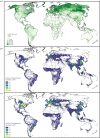The role of soil in the contribution of food and feed
- PMID: 34365816
- PMCID: PMC8349637
- DOI: 10.1098/rstb.2020.0181
The role of soil in the contribution of food and feed
Abstract
Soils play a critical role in the production of food and feed for a growing global population. Here, we review global patterns in soil characteristics, agricultural production and the fate of embedded soil nutrients. Nitrogen- and organic-rich soils supported the highest crop yields, yet the efficiency of nutrient utilization was concentrated in regions with lower crop productivity and lower rates of chemical fertilizer inputs. Globally, soil resources were concentrated in animal feed, resulting in large inefficiencies in nutrient utilization and losses from the food system. Intercontinental transport of soil-derived nutrients displaced millions of tonnes of nitrogen and phosphorus annually, much of which was ultimately concentrated in urban waste streams. Approximately 40% of the global agricultural land area was in small farms providing over 50% of the world's food and feed needs but yield gaps and economic constraints limit the ability to intensify production on these lands. To better use and protect soil resources in the global food system, policies and actions should encourage shifts to more nutrient-efficient diets, strategic intensification and technological improvement, restoration and maintenance of soil fertility and stability, and enhanced resilience in the face of global change. This article is part of the theme issue 'The role of soils in delivering Nature's Contributions to People'.
Keywords: biogeochemistry; global food and feed; nature's contribution to people; nitrogen; phosphorus; soils.
Figures





Similar articles
-
Phosphorus flows in a peri-urban region with intensive food production: A case study.J Environ Manage. 2017 Feb 1;187:286-297. doi: 10.1016/j.jenvman.2016.11.040. Epub 2016 Dec 1. J Environ Manage. 2017. PMID: 27914350
-
The role of soils in provision of energy.Philos Trans R Soc Lond B Biol Sci. 2021 Sep 27;376(1834):20200180. doi: 10.1098/rstb.2020.0180. Epub 2021 Aug 4. Philos Trans R Soc Lond B Biol Sci. 2021. PMID: 34365815 Free PMC article.
-
The role of soils in habitat creation, maintenance and restoration.Philos Trans R Soc Lond B Biol Sci. 2021 Sep 27;376(1834):20200170. doi: 10.1098/rstb.2020.0170. Epub 2021 Aug 4. Philos Trans R Soc Lond B Biol Sci. 2021. PMID: 34365817 Free PMC article. Review.
-
The phosphorus cost of agricultural intensification in the tropics.Nat Plants. 2016 Apr 18;2(5):16043. doi: 10.1038/nplants.2016.43. Nat Plants. 2016. PMID: 27243646
-
The role of soils in regulation of freshwater and coastal water quality.Philos Trans R Soc Lond B Biol Sci. 2021 Sep 27;376(1834):20200176. doi: 10.1098/rstb.2020.0176. Epub 2021 Aug 4. Philos Trans R Soc Lond B Biol Sci. 2021. PMID: 34365829 Free PMC article. Review.
Cited by
-
Trace Element Contents in Petrol-Contaminated Soil Following the Application of Compost and Mineral Materials.Materials (Basel). 2022 Jul 28;15(15):5233. doi: 10.3390/ma15155233. Materials (Basel). 2022. PMID: 35955168 Free PMC article.
-
The role of soils in delivering Nature's Contributions to People.Philos Trans R Soc Lond B Biol Sci. 2021 Sep 27;376(1834):20200169. doi: 10.1098/rstb.2020.0169. Epub 2021 Aug 4. Philos Trans R Soc Lond B Biol Sci. 2021. PMID: 34365820 Free PMC article.
-
Investigating the spatial variability of soil parameters and mineralogical characterization in the tea growing area of Kishanganj district Bihar India.Sci Rep. 2025 Aug 11;15(1):29372. doi: 10.1038/s41598-025-04561-9. Sci Rep. 2025. PMID: 40790121 Free PMC article.
-
Improving Fertilizer Use Efficiency-Methods and Strategies for the Future.Plants (Basel). 2023 Oct 23;12(20):3658. doi: 10.3390/plants12203658. Plants (Basel). 2023. PMID: 37896121 Free PMC article.
-
Potassium silica nanostructure improved growth and nutrient uptake of sorghum plants subjected to drought stress.Front Plant Sci. 2024 Jul 17;15:1425834. doi: 10.3389/fpls.2024.1425834. eCollection 2024. Front Plant Sci. 2024. PMID: 39086913 Free PMC article.
References
-
- Nielsen UN, Wall DH, Six J. 2015Soil biodiversity and the environment. Annu. Rev. Environ. Resour. 40, 63-90. (10.1146/annurev-environ-102014-021257) - DOI
-
- Brevik EC, Sauer TJ. 2015The past, present, and future of soils and human health studies. SOIL 1, 35-46. (10.5194/soil-1-35-2015) - DOI
-
- Horton RE. 1933The role of infiltration in the hydrologic cycle. Eos, Trans. Am. Geophys. Union 14, 446-460. (10.1029/TR014i001p00446) - DOI
-
- Oertel C, Matschullat J, Zurba K, Zimmermann F, Erasmi S. 2016Greenhouse gas emissions from soils—a review. Geochemistry 76, 327-352. (10.1016/j.chemer.2016.04.002) - DOI

